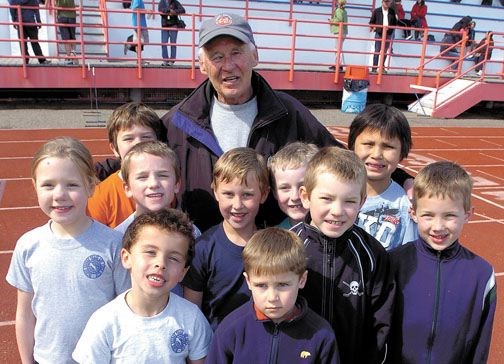Tom Masich liked the quality in the athletes he watched run, jump and throw the past two days at the North Central zone high school track and field championships.
But there's no doubt he was disappointed in the quantity.
Just 140 athletes made showed up for the two-day meet, a significant improvement over last year's all-time low of 109, but it still pales in comparison to what Masich used to see crowd into the stadium which now bears his name.
"We used to have 500-700 kids for the zone meet back when we had the Peace Country, 100 Mile House and Williams Lake involved and that just doesn't happen any more," said Masich.
"It started with all this technology and kids have other interests that don't require physical output. There should be 140 kids from PGSS instead of 140 kids in the whole meet."
In reality, PGSS secondary school had just four athletes entered in the zone meet.
Masich remembers in 2003, when he was head coach of the Prince George Track and Field Club, there were 32 juvenile girls competing in the hammer throw event alone, including 21 from Bella Coola and eight from Fort Ware. This year there were no juvenile girls tossing the hammer.
"It just shows what's happened when all the old standby coaches and organizers have dropped off the map." Masich said. "It's just a travesty that it's happened because so many of these kids are capable of going on university track teams when they got out of school."
With obesity rates skyrocketing and predictions of non-active lifestyles leading to the current generation of teenagers as the first who will not live longer than their parents, Masich points the finger of squarely at the school system for what he sees as a failure to promote sports programs geared towards all students.
"I don't think there's a comprehensive system of organized athletics in the schools which teaches the kids to be interested in fitness and health," said Masich. "We should be proactive, not reactive, but the whole system is set up to be reactive. Consequently we have illness and obesity in kids because there are no proactive programs being designed for them."
Back in 2002, Masich met with Shirley Bond, then the Advanced Education Minister, and Gordon Hogg, who was Minister for Children and Family Development, in response to their request for input on how to get youth in the province more active.
"We had a discussion about fitness and kids and Shirley asked what I thought would improve things and I said full-time physical education teachers in elementary schools and they just balked at that, the meeting was almost over at my stating that," said Masich. "They took note of it but they indicated it probably wouldn't happen."
Masich is convinced bringing in young and enthusiastic gym teachers would take that job out of the hands of teachers who are not comfortable nor qualified to physically show kids how to play sports or perform the movements needed for athletic success. Instead, kids pick up on teachers who would rather not be in a gymnasium, and if they are not already athletically inclined those kids are more likely to get turned off gym class.
If it costs more up front to hire more gym teachers, Masich said that money would be well spent. The province could recoup that cost of those salaries several times over in money saved on health care costs to treat conditions that are the result of unfit bodies. He'd like to see some form of gym class mandatory in all grades, rather than just up to Grade 10, the current minimum in B.C. schools.
"They're relying on clubs like the track club or the soccer association to do the job that the schools should be doing," Masich said. "They have to be more active in the school programs and the government has to be more active in promoting health and physical education in the schools."



